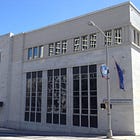Logs and Mortar of the New Deal
ANNETTE ON THE ROAD Pandemic Time Out In a Hotel Built By Desperately Poor Lads a Lifetime Ago,
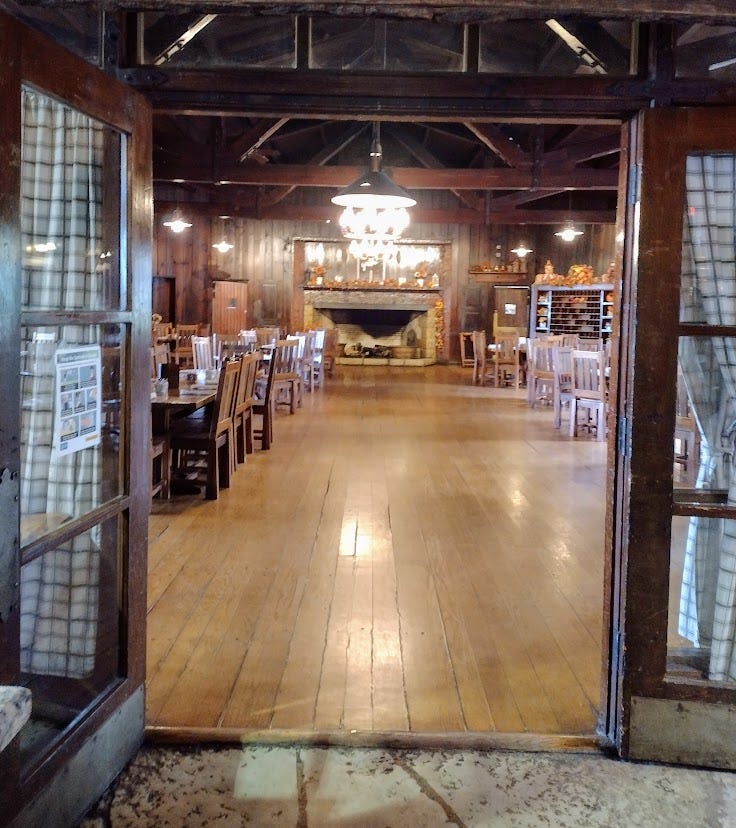
I'm getting closer to a major milestone at Non-Boring History, and would very much appreciate free readers who can to take the plunge, and become Nonnies, paying subscribers. The rewards for you are many, as you become part of a community that's coming to the rescue of academic history simply by having fun reading, chatting, and visiting museums!
Note from Annette, August 17, 2024
I’m working like mad on several NBH posts that can’t be done any faster! So, today, a throwback I think you’ll enjoy.
Hoosen and I started taking our first tentative steps out of the house in fall of 2021, and—of course—we ended up in a place connected with my beloved President Franklin Delano Roosevelt. Okay, that had to be divine intervention, because, as you will see, we weren’t drawn here by FDR, but he was waiting for us anyway.
FDR (for it is he) What in the world are you talking about, Dr. Laing? Do you honestly believe I have the time to gallivant all over the country admiring my handiwork? I have a nation and a world to save. Even the First Lady can’t be everywhere. You know, we’ve never been busier since we died, and this year has been among the busiest. People treat us like Protestant saints, very peculiar. Also rather gratifying.
ANNETTE: Sorry, Mr. President. I meant you were here in spirit, and in your projects. Um, would you mind not lighting up in here, please? Thanks.
FDR {returns pack of Camels to his pocket} Look, don’t forget to remind your people about Dr. Walker’s Living New Deal project attached to UC Berkeley. You know, Starved Rock Lodge is a fine example of what the New Deal set out to accomplish. I’m pleasantly surprised to find it still in operation so far in the future.
ANNETTE I agree, sir, and happy to help. Readers, here’s a link to an awesome project that is working to map all the things the New Deal built that we’re still using. And you can get involved with a minimum of effort and maximum of fun! Here’s my post, and my interview with Dr. Richard Walker, director of the Living New Deal. It’s fascinating and inspiring stuff.
When you are a Nonnie (a paying annual or monthly subscriber) you support my work, plus you get access to more than 450 Non-Boring History posts like these, participation in the community in comments and meet-ups (online and even in person), and so much more. Join us!
September 26, 2021
Poor Hoosen. He never even gets to take a little holiday without his wife popping on her historical x-ray specs and providing a running narration.
Yes, Hoosen and I succumbed to COVID-related cabin fever. We wanted to take as socially-distanced a trip as we could, one in which we might not feel like we're constantly staging some kind of covert operation: “Alert! Incoming on left!”
So we took an uncomplicated two hour drive south through an almost entirely rural landscape.
Fun Fact: Drive South from Madison, WI, and you will eventually reach Nashville, without ever having driven through a city. Contrary to the mental map that most of us non-Midwesterners have of Illinois as urban and industrial, the entire trip takes place through farmland, in an area famous for the famous people who have left it.
Yes, from Dick Van Dyke to Ronald Reagan, this pleasant flat region of waving corn Americana has legendarily inspired its young people to say “Gosh, I think I'll go West/East/Anywhere But Here.” These emigrants are typically regarded as weirdoes and turncoats, until they actually become famous, when they are suddenly elevated locally to Beloved Native status, and have streets named after them.
Well, Whaddya Know
There is one spot in this flat plain of Illinois corniness that might surprise you with its rugged beauty, and that's where we were headed: The Illinois River Valley, and Starved Rock State Park in particular.
Starved Rock. The name gets your attention, doesn't it? But the legend, you can look up on Wikipedia.
What drew us here was the promise of bald eagles, and lots of them.
Unfortunately, I'm not so much an amateur ornithologist as I am someone who likes to see big birdies. So I didn't know that the Big Birdie Show at Starved Rock takes place in winter, as the eagles stop by en masse. Never mind. At Starved Rock, Hoosen and I spotted about four big birdies he claims were eagles, silhouetted against the bright blue sky.
I was happy to agree they were eagles for the sake of marital harmony, even though I thought they looked a bit vultury, myself. But we definitely saw a large group of pelicans (I believe the proper description is “crap-ton of pelicans”) hanging out by the river, so there's a win.
And big birdies aren't Starved Rock State Park's only claim to fame. It's home to numerous spectacular deep (non-West deep, but still) sandstone canyons along the river.
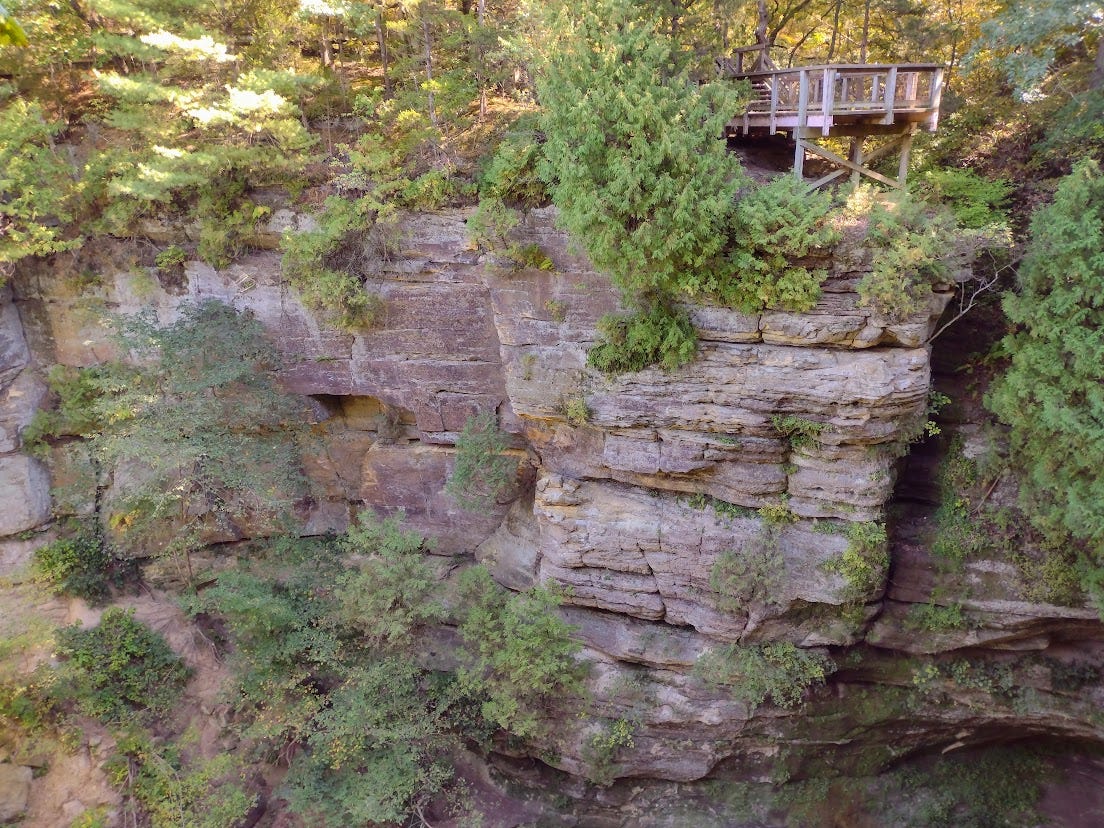
These beautiful formations, I discovered too late, can only be accessed by either vigorous walks up and down long wooden staircases, or via a tourist trolley at ground level. Too proud to take the bus, or to admit to myself that I'm too out of shape and afraid of heights to hike the trail, I hiked anyway, with much groaning about arthritic knees and vertigo to a kindly yet eye-rolling Hoosen.
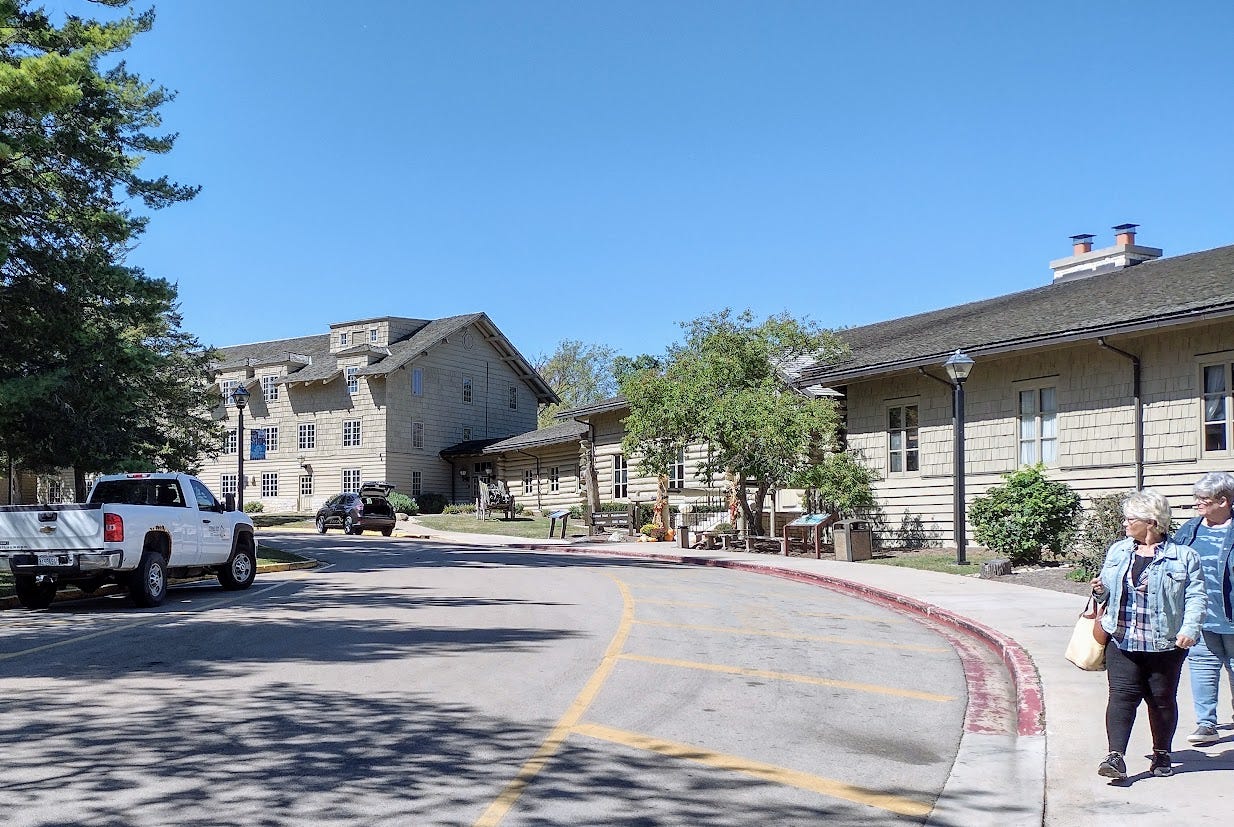
A Five-Star Hotel Kind of Person
We didn't camp. I don't camp.
Ooh, story time! I remember flying home to California after a job interview, a long with a fellow grad student who'd been interviewed by another academic department at the same university in Tennessee. She happened to be French.
So we compared notes. I recall her puffing on a Gauloise during the chat, which can't possibly be right, so I imagined it, but it fits perfectly with my recall of her words and accent. “I ask in the interview,” she said, “What is there to do 'ere? All they tell me is camping and hiking. Do I look like I like to 'ike?” She sniffed contemptuously. “I am a five-star hotel kind of person.” Puff. Puff.
Ever since, when roughing it is proposed as a vacation option, I have said, in my best French accent, “I am a five-star hotel kind of person.”
Sadly, I can't actually afford a five-star hotel, and since Americans have traditionally associated enjoying nature and scenery with a certain masochistic degree of discomfort and lack of showering opportunities, and because Hoosen has resisted my hints that we ought to invest in a glamping vehicle, we often struggle a bit to combine outdoorsy vacations with the level of civilization a European city person requires.
Enter Starved Rock Lodge, the only lodging in the park, which looks like a scaled-down Ahwanee Hotel, for folks who know Yosemite National Park.
Enter the CCC
Speaking of starved, most of the hotel was built back in the 1930s by unemployed single young men rescued from severe poverty during the Great Depression. They were aged 18-22, and were employed by the federal government, through the Civilian Conservation Corps, or CCC, a New Deal program created by the newly-elected Franklin Delano Roosevelt. They lived and worked in military-style conditions. For this, they were paid the princely sum of $25 a month, $20 of which was sent directly to their parents and siblings to save them from starving, too.
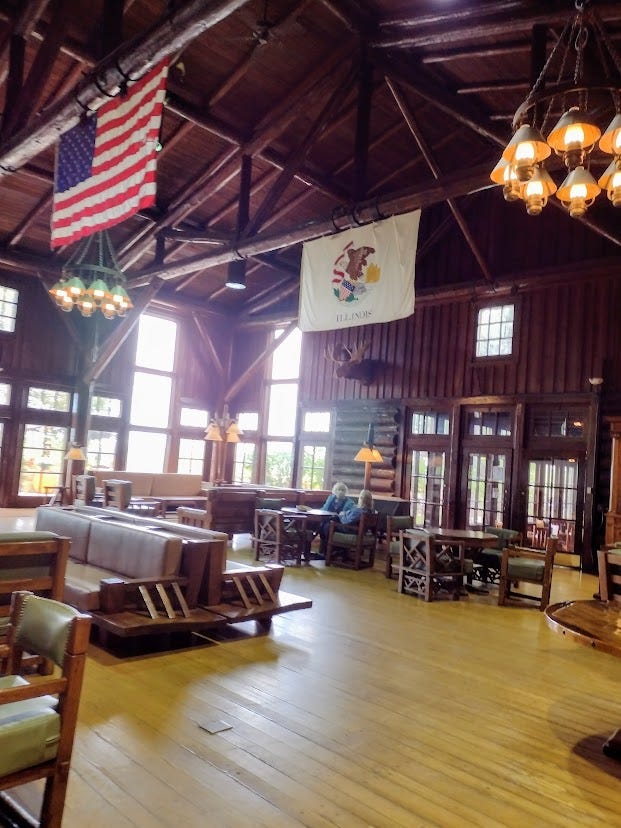
At the park visitor center, we watched a brief but touching movie (likely from the 1980s) about the CCC in Illinois. One elderly man in a CCC veterans cap recalled, with great emotion, how his father, a coal miner, had tried to escape that insecure and dangerous occupation by turning to farming. He failed as a farmer, like so, so many people with too few resources or decent land, leaving the family almost destitute. This young man, perhaps still in his teens, ended up supporting the family with his CCC income.
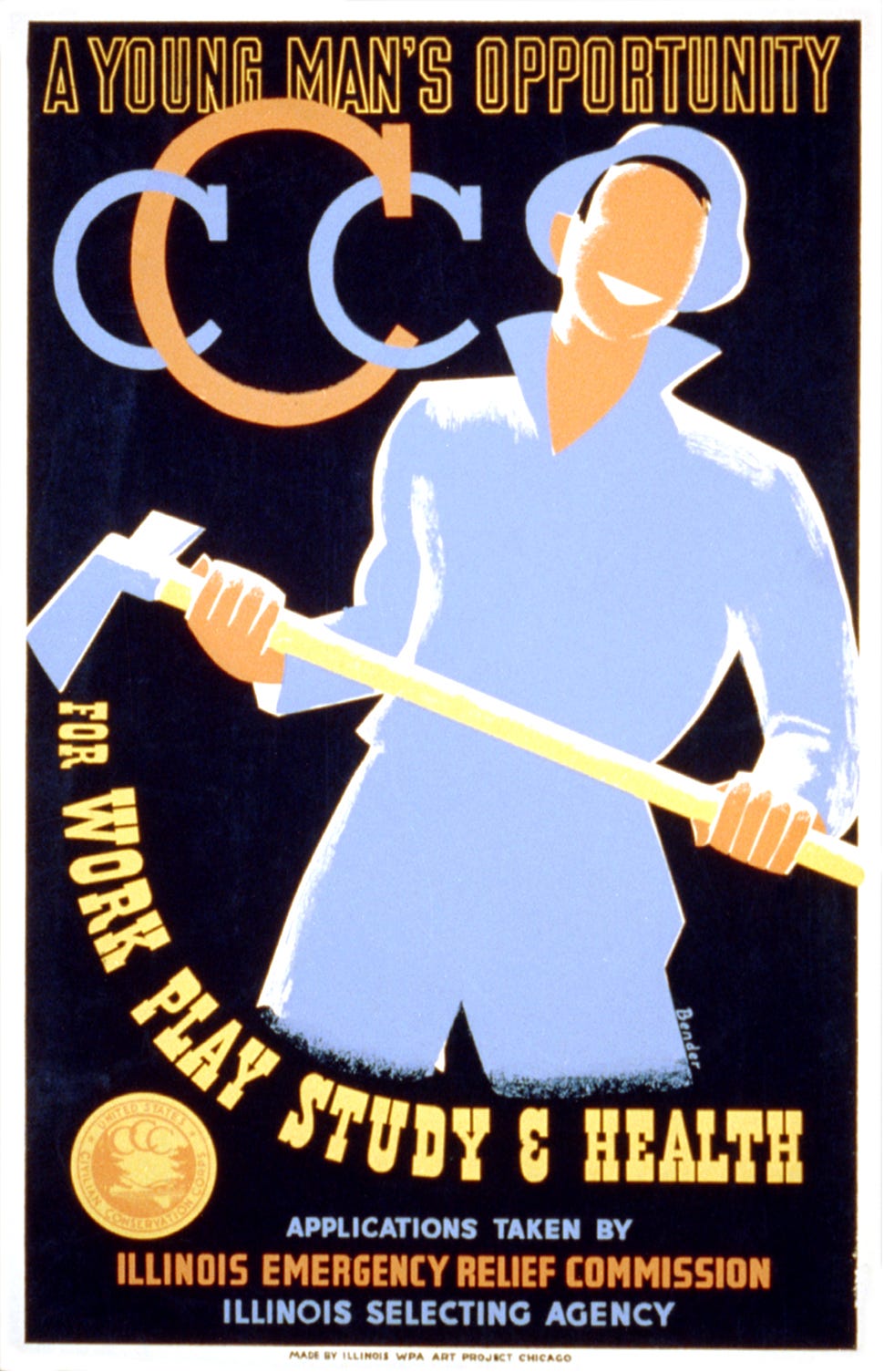
This kind of story was repeated by other CCC veterans in the film. The CCC gave them a lifeline in a terrible time: Regular meals, a place to sleep, and the chance of a high school education. Many poor Americans were semi-literate, even illiterate. The lads who entered the CCC also often suffered from malnutrition: Poverty was the norm for many Americans even before the Great Depression.
The CCC and Race
The CCC employed Black Americans and other people of color but, to the surprise of nobody, they were segregated in different camps, denied leadership opportunities, and, in the South, often refused admission to this and other New Deal programs. You can read more about segregation in the CCC here, at the Living New Deal project.
Poverty and Pride
One of the saddest recollections in the Visitor Center film? A man recalled his brother being saved from the life of a “hoodlum” by the CCC. The young man’s crime? Stealing food for his family.
Blaming yourself for being poor, and encouraging the poor to blame themselves, is a defining feature of American culture, and one I have always found terribly cruel. The CCC was a lifeline, and it did build confidence, even though its working assumption seemed to have been that poor men needed their characters built more than privileged people did.
And yet anyone who has ever run a small business knows, you have to spend money to make money. Most Americans didn't have enough opportunity or capital to provide even the scantiest of livings before the Depression (despite the carefree image of the Twenties, it was a time of massive inequality, and there's no way to explain that without a major detour in this post, so later).
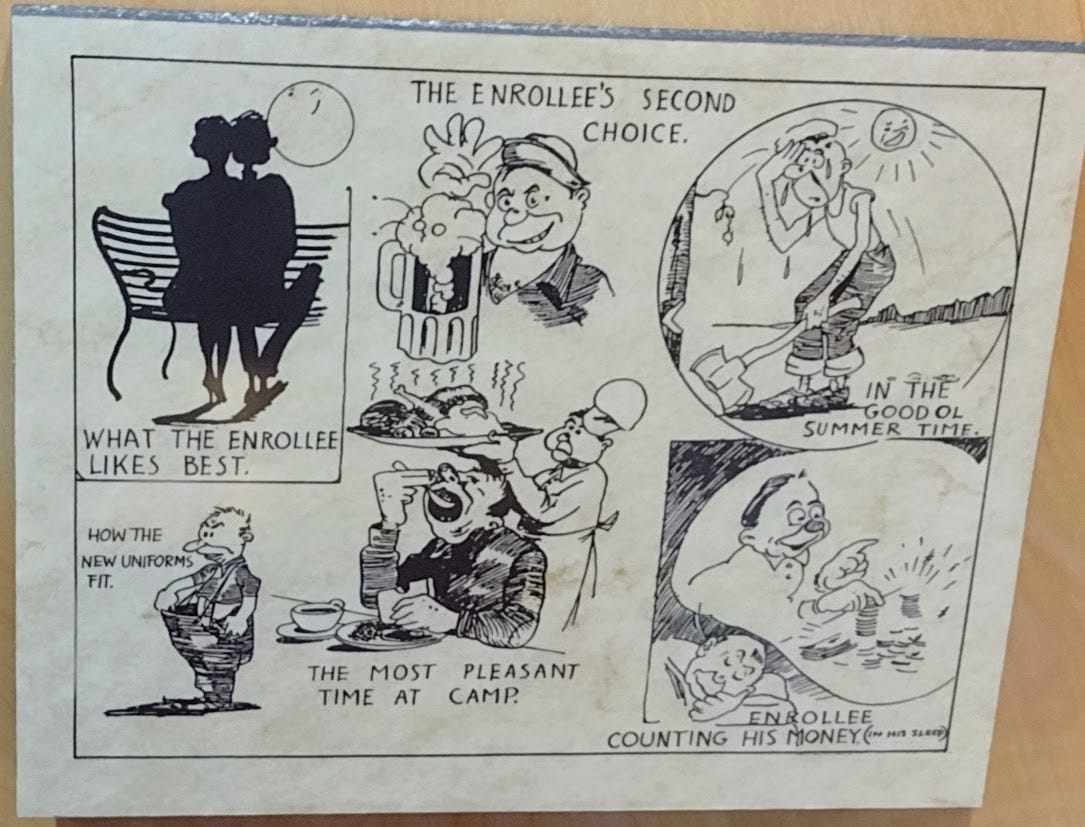
In exchange for food, lodging, a uniform, and a small allowance, the young CCC men rose at dawn from their barracks (the US Army ran the program) and gave the nation day after day of hard physical labor. And much of the work they did has provided recreation to millions ever since, because an awful lot of the infrastructure of today's state and national parks, including our hotel, was the work of the CCC. The impact on quality of life and the economy in Illinois alone was and is impressive.
As well as building the Starved Rock Lodge, and other buildings in state parks, the CCC laid more than a thousand miles of trails and planted 60 million trees, in Illinois alone. You can watch the six minute film about their work at Starved Rock from the Illinois Department of Resources here:
The CCC was never just about helping (or fixing) the poor, mind. It was, like much of Roosevelt’s New Deal, and contrary to the allegations of socialism that were thrown at him, about saving American capitalism. The CCC was brewed up in the shadow of the Bonus Army of 1932, a ragtag band of thousands of destitute First World War veterans and their wives and kids. Starting in Oregon and picking up more folks along the way, they marched across America to plead for an immediate payout of the federal bonus for their wartime service that they had been promised for 1945 (the year—the future end of WWII— is a coincidence, my conspiracy-minded friends). As one veteran interviewed for a newsreel crew put it despairingly, as he sat on the US Capitol steps, if the bonus wasn't given to him now, “You might as well give it to the undertaker.”
As thousands gathered in the Capital, and right outside the Capitol, there was a genuine fear in Washington, DC of revolution in that darkest year of the Depression. The Army, complete with tanks, was sent in to disperse the veterans and destroy their encampments, in scenes that shocked newsreel audiences across the nation.
That’s why, when Franklin Delano Roosevelt took office, the first Americans to be put to work in government programs were not parents or women caring for the elderly, but single young men, the most likely to lead a rebellion.
The CCC was ended in 1942, when young men went to war. But it was regarded as a success, and provided the model for, among others, the California Conservation Corps (Motto: Hard Work, Low Pay, Miserable Conditions, and More!), which started in 1976.
Today, with its veterans all dead, the federal CCC is mostly a distant and fuzzy non-memory, even as underfunded and neglected state and national parks struggle to cope with millions of Americans discovering them in 2021, as the pandemic drives us to connect with nature.
I often think that we today are like H.G. Wells' future humans, the Eloi, in The Time Machine, especially as depicted in the 1960 movie (which you will be shocked to know I love). We live languidly in the dusty remains of a society we no longer maintain, in an infrastructure that a young, highly-educated immigrant I recently met described bluntly as “Third World”. He would know: He’s from Bangladesh.
It's ironic, really, given the massive prosperity of the US economy in recent decades. Ironic, in that we still rely on a program that was launched and accomplished so much while the American economy was hovering on the brink of freefall.
But Who Knows That?
This, folks, is why it bothers me that we brand things “history”, and “old”, and don’t actually do what academic historians do: Consider how the past is still with us, in the form of the present. I well recall how the New Deal is taught in US history surveys: Here’s a bunch of meaningless bloody initials to memorize, spit back, and, gratefully, forget. Nothing to see here. Move on. And my British friends who tease me that American history is too short to be worth remembering might ask themselves what we learn about the US and the UK today from studying it.
Sure, the work of the CCC is highlighted at Starved Rock, but only for the curious. You can see a good small display at the Park Visitor Center (sponsored by the Daughters of the American Revolution, bless 'em) but you have to stop, look, and think, or it's just “old timey stuff”. That movie I watched is only one of several on different themes at the Visitor Center, and you do have to request it.
Most people have no idea that the Lodge, the trails, boardwalks, staircases and bridges that made our visit possible in 2021 were built by a government program in the 1930s, that our free access isn’t really free: it was paid for by young people who were shut out of education at a young age, and who gratefully accepted subsistence pay for hard and dangerous work.
The Visitor Center at Starved Rock State Park has an actual little bookshop, something you seldom see anymore, with books on the many layers of Starved Rock: The natural life of the park, the history of the indigenous people who once called it home, the French who came to trade and convert, and, yes, the CCC. On the day we visited, the bookstore was staffed by Pam. She's been working with visitors at the site since the early 70s, first as a professional interpreter, and now as a gift shop volunteer. She's delightful, and overhearing her explain the site history to visitors, it was clear that she's perfect: Enthusiastic and informed and friendly without wearing people out. Not that she said anything to this effect, but I'm willing to bet that Pam, like the lads of the CCC, has given far more for the general good than she has received.
Even today, the nearby town of Utica depends on income from the two million (you read that right) visitors who come to Starved Rock each year. As Pam explained to us, Illinois doesn't have a National Park. This Illinois State Park is its equivalent, so it is a big draw, especially to Chicagoans, bringing their tourist dollars from a thriving urban economy to a struggling rural one. This is not without its tensions, I expect. That was true back in the 1930s, when, according to an info sheet the Lodge front desk gave me, local workers protested that the work building the Lodge was being given to the non-local CCC men. The project was eventually handed over to and finished by local workers.
I don't doubt it. Government and politics in a mixed economy, one with public and private elements, is always a balancing act. I do wonder if the locals would have ever benefited from the Park facilities without the CCC: A private hotel was here long before, but it struggled to stay open, and no wonder when it was so hard to access the canyons without bridges and walkways.
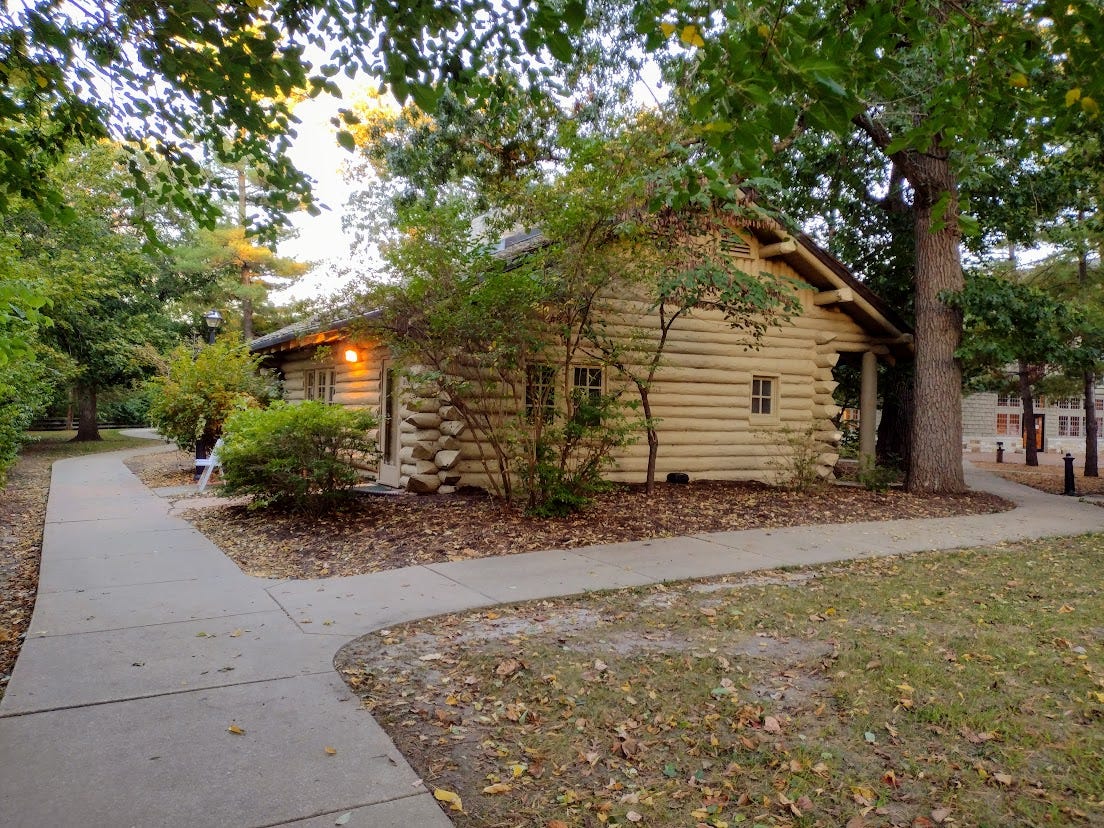
I looked at the handhewn logs in the walls of our room, in one of the original CCC cabins, and wondered about the lads who hacked away at them, and hefted them into place. Many of these men went on to join the army in 1942. Some of them never came home. They were veterans who served this country long before they joined the War, and their work building the nation’s parks is a gift that keeps on giving.
American Readers: Are you familiar with CCC projects that are still serving your community or state?
Learn More: A good place to start is The Living New Deal, which links to reliable content across the web.
Become a supporting subscriber, and you get instant access to my voiceover of this post, read in one take (ooh, the excitement!) in my English/American/Wee Bit Scottish accent.




